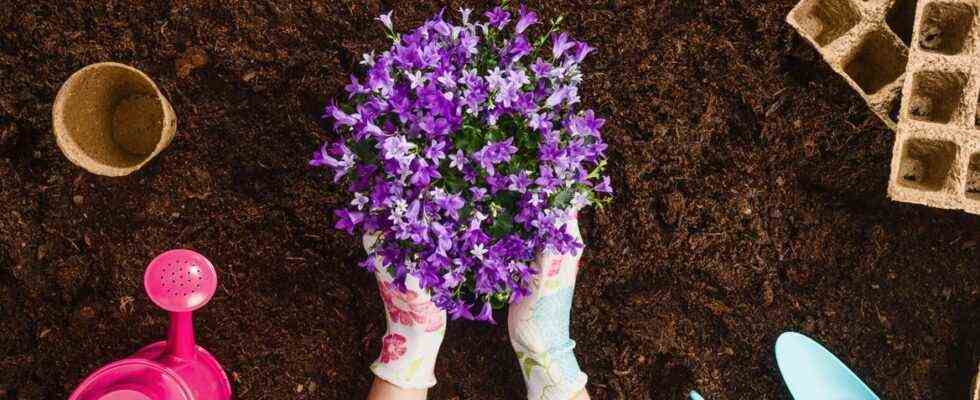An essential preparation
To plant seeds in your garden, you must first choose the right time. Since the earth needs heat to allow the sown plant to develop, it is better to choose spring. This is indeed the ideal period.
Also, pay attention to the place in the garden where you are going to sow your seeds. It is better to choose a sunny corner, which does not keep standing water.
This done, it is essential to prepare the soil. This is an essential step for the successful arrival of the future plant. In this area, the first thing to do is to remove the weeds from the land chosen for sowing.
Indeed, they do not mix well with flowers, and risk encroaching on their living space. It is the same thing with small stones that the ground could contain.
It is not essential to dig the earth to prepare it. If the terrain is light, just rake it. If the earth is more compact, it is necessary to crumble it and break up the clods that it often forms.
And don’t forget to feed the earth with a organic fertilizer, manure or a composition based on bone powder or guano for example. But you can also recycle some of your household waste to make compost that will also fertilize your land.
Choose the way to sow
Once the soil is prepared, it is time to proceed with the actual sowing. But there are several ways to go about it.
Even if you cannot reproduce exactly the harmonious gesture of the peasants of old, you can still try to sow on the fly. This method of sowing is perfect for giving shape to a flower bed or a bed.
The main difficulty is to distribute the seeds well. Indeed, it is necessary to avoid that these, thrown on the fly, do not accumulate in small piles.
Mixed with a little sand, the seeds gain volume and are dispersed more easily on the chosen ground. Remember to press the seeds into the soil with the back of the rake.
As the name suggests, row sowing involves digging a straight furrow, in which you deposit the flower seeds. It remains to bury them with the same tool or to fill the hole with the hand. This technique is useful for planting flowers along a wall.
But you can also let your imagination run wild and give various shapes to the furrow, so as to draw various patterns for your future flower beds.
If you choose to sow in pockets, you will have to dig small holes, called precisely “pockets”, and deposit some seeds. Among the flowers that will have grown, you can choose the one that will seduce you the most.
You can also be sure that, of these seeds, at least one will give a beautiful flower.

How to choose your flowers and when to sow them?
You are fully aware of how to prepare your land, and you have also chosen the seedling that best matches what you want to achieve. Before proceeding, however, it is still necessary to know which flowers you want to sow.
You can choose seeds from perennials, which will adorn your beds for several years. Thus, you will not have to renew its disposition. Indeed, many perennial flowers, often very decorative, can be obtained by means of a seedling.
This is the case, among many others, of columbine, carnations, large daisies or even lupines.
But you can also set your sights on annual flowers, which germinate for one year, or biennials, which last for two years. For them, too, sowing is often the best way to come to maturity.
Among the first, we find for example, nasturtiums, immortelles, marigolds or sunflowers, all easy-care flowers. The latter include, for example, forget-me-not, bellflower, pansy or horned violet.
It is also necessary to choose the period of sowing. Indeed, it cannot be done at all times. In principle, the most favorable period is spring, between mid-March and mid-June, when you are sure that there is no longer any risk of frost.
For the rest, the time of sowing depends on the type of seed as also on the region where you live.
Other tips to be sure of successful sowing
Finally, to fully succeed in your seedlings, you must pay attention to certain elements. First of all, check the expiry date which, in principle, is indicated on each packet of seeds.
If this date has not passed, and you have not used all the seeds, carefully close the bag. From then on, these seeds can still serve you next year. Otherwise, of course, they can no longer be used.
Also remember to protect your seedlings. If you do not cover them with a net, placed a little above the ground, the birds will not fail to feast on the seeds that you will have left at their disposal.
Watering is of course an essential point. Remember that your seeds should germinate in cool soil. When the young shoots start to appear, do not forget to water them every day, but without having too heavy a hand. And when the plants grow larger, this watering can be less frequent.
Finally, one last tip: when the stems reach a certain height, think about thinning them. Indeed, if all the seeds have germinated, you will get a somewhat bushy bouquet. It is better to keep only a few plants, so that the others do not suffocate them.

